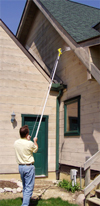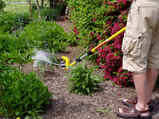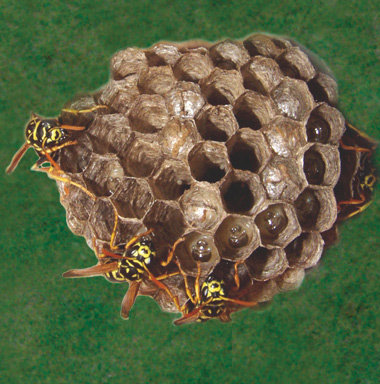| 4Most Innovations, LLC |
| 40 W 4th St |
| Minster, OH 45865 |
| PH.: 419.628.2812 |
| FX.: 419.628.3416 |

|
The Gotcha Sprayer and Gotcha Sprayer Pro adaptors enable you to attach and trigger any aerosol, including wasp and hornet spray from an extension pole. Either adaptor is the ultimate tool for killing wasps, paper wasps, yellow jackets, carpenter bees, and hornets nests.� The Gotcha Sprayer Pro will trigger virtually any aerosol can diameter, length, and nozzle style. It attaches to any extension pole with a standard American threaded tip.� It will attach to your existing extension pole (if it has a standard American threaded tip) or you can purchase an extension pole from our online store. Paper Wasps (Polistes): Paper wasps are fairly common in the Northeast. The paper wasp queen is responsible for reproducing and setting up the initial nest. The queen paper wasp will start building a nest by attaching a central strand to the sheltered structure. This strand is made from chewed wood or plant material and water which she builds using her mouthparts. Paper wasp nests resemble gray, paper honeycombs and are generally round in shape. The rest of the comb is build off of this central strand. Once the queen has built several cells, she will begin to lay eggs in the bottom of each cell. These eggs will develop into either male or female larvae. Once the larvae are old enough they will build tops on the cells to close off the top of the cell. There they will remain until they become pupae. The workers are responsible for expanding the nest and feeding the larvae. In spring and early summer paper wasps will feed the larvae with caterpillars, while the adults generally feed on nectar or fruit from apple or pear trees. The upside is that paper wasps act as a natural control agent for caterpillars. The downside is that paper wasps tend to build their nests in areas that are sheltered, usually under the eaves, around decks, play sets, Satellite dishes, and out buildings. Paper wasp queens are generally the same size as the female workers. As the colony grows, some of the new wasps are males and some are females. The male and female paper wasps will mate. The male paper wasps will die over the winter, while the female paper wasps will find shelter over the winter and start new colonies in the spring. Many times this shelter can be indoors and can create a problem for homeowners in the spring. Paper wasps can be controlled relatively easy using the standard wasp and hornet spray. Using a Gotcha Sprayer or Gotcha Sprayer Pro adaptor and an extension pole, you can simply attach a can of wasp and hornet spray, extend the extension pole and spray the nest in short quick blasts. Do this around dusk and the paper wasps will never know what hit them. Using a scraper to remove the old nest, will help ensure that other queen paper wasps won�t move in. Using the Gotcha Sprayer in addition to the wasp and hornet spray will allow you to minimize the amount of chemical sprayed all over the house and yourself. You will be able to position the wasp and hornet spray directly in front of the nest without trapping yourself on a ladder. Some wasp and hornet sprays are petroleum based and can discolor siding, damage shingles, and kill surrounding foliage. Using wasp and hornet spray with the Gotcha Sprayer adapter and an extension pole allows you to minimize the mess and over-spray. Spraying wasps, yellow jackets and hornets is much easier with the Gotcha Sprayer and Gotcha Sprayer Pro.� Spraying cans of aerosol wasp and hornet spray from the ground when trying to reach the peak of a roof or the eaves is a messy job. The over-spray will get on your house, in your eyes, and in your lungs. Not to mention the risk of spraying angry wasps, yellow jackets, hornets, or carpenter bees from up on a ladder. Simply insert a can of wasp and hornet spray, secure by tightening the strap, attach to an extension pole, and spray. By positioning the wasp and hornet spray directly in front of the nest, there is less over-spray and is much better than using a ladder.� With the Gotcha Sprayer Pro you can easily add a duster for applying insecticide dusts.� Sometimes wasp and hornet spray alone will not kill carpenter bees. Using the Gotcha Sprayer Pro with a powder duster, enables you to leave a residual dust in the carpenter bee nest, eventually killing the carpenter bees.� The Gotcha Sprayer Pro can be purchased alone or as a kit, enabling you to spray aerosols or powder dusters with the same unit, with price much less than the Bee Pole or the Dustick (dust stick).��
The combination of the Gotcha Sprayer Pro and our Powder Duster let's you apply the dust close to the vegetation, reducing waste and drift. |
|
||||||||||||||||||
|
 The stinging insects that people most commonly come in contact with are classified in the order of Hymenoptera. That includes: yellow jackets, hornets, and wasps. In general, yellow jackets, hornets, and wasps have a negative reputation around people, however when they are not intruding in our personal space, they can be helpful in certain ways: yellow jackets, hornets, and wasps feed their young largely on flies and caterpillars. Yellow jackets, hornets, and wasps help keep these pest populations in check. Unfortunately, the personality of these insects changes as the season progresses. Early on yellow jackets, wasps, and hornets will only defend their nests when they feel threatened. As the season progresses and food sources become less available, they become more aggressive. Yellow jackets, hornets, and wasps are considered social insects and live in colonies. Within the colonies there is a distinct hierarchy between builders, gatherers, and reproducers. Some colonies of insects continue for many years, others such as yellow jackets, hornets, and wasps start over every year.
The stinging insects that people most commonly come in contact with are classified in the order of Hymenoptera. That includes: yellow jackets, hornets, and wasps. In general, yellow jackets, hornets, and wasps have a negative reputation around people, however when they are not intruding in our personal space, they can be helpful in certain ways: yellow jackets, hornets, and wasps feed their young largely on flies and caterpillars. Yellow jackets, hornets, and wasps help keep these pest populations in check. Unfortunately, the personality of these insects changes as the season progresses. Early on yellow jackets, wasps, and hornets will only defend their nests when they feel threatened. As the season progresses and food sources become less available, they become more aggressive. Yellow jackets, hornets, and wasps are considered social insects and live in colonies. Within the colonies there is a distinct hierarchy between builders, gatherers, and reproducers. Some colonies of insects continue for many years, others such as yellow jackets, hornets, and wasps start over every year. Using the
Using the 